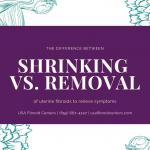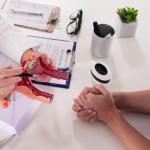
Choosing to undergo Uterine Fibroid Embolization (UFE) is a significant step toward finding freedom from the discomfort and pain caused by fibroids. As a minimally invasive alternative to surgery, UFE can help with symptom relief with less downtime and fewer risks.
UFE (also referred to as Uterine Artery Embolization or UAE) is performed in an outpatient setting under light sedation and does not involve general anesthesia or sutures. A local anesthetic is administered to prevent you from experiencing pain during the procedure, and then a catheter is inserted. The procedure usually does not last longer than an hour, and you can return home the same day.
In this article, we’ll discuss how to prepare for uterine fibroid embolization, what to expect after UFE treatment, and when to call your fibroid specialist.
Who is a Candidate for UFE?
A candidate for Uterine Fibroid Embolization (UFE) is typically a woman who has symptomatic uterine fibroids and is seeking a non-surgical treatment option.
Qualifiers for UFE include:
Symptomatic Uterine Fibroids: This includes heavy menstrual bleeding, pelvic pain or pressure, frequent urination, or difficulty with bowel movements.
Desire to Avoid Surgery: Women who want to avoid a hysterectomy or myomectomy (surgical removal of fibroids) due to concerns about recovery time, risks, or fertility preservation.
Age: UFE is most commonly recommended for women in their 30s or 40s, often those who are nearing menopause or are done with childbearing. However, it can be done for younger women if fertility preservation is not a concern.
Wants to Treat Multiple Fibroid and Sizes: Uterine Fibroid Embolization (UFE) stands out among fibroid treatments by addressing all fibroids within the uterus, making it effective for individuals with a single fibroid or multiple fibroids of varying sizes. Additionally, UFE can treat adenomyosis, a less common condition that also causes heavy and painful menstrual cycles.
Desire for Fertility Preservation: UFE is an option for women who wish to preserve fertility, as it does not involve removing the uterus and has been shown to have a lower risk of complications for future pregnancies compared to surgery.
UFE Preparation
If you’re interested in exploring fibroid embolization treatment, the first step is to schedule an initial consultation with a fibroid specialist.
Your Initial Visit & UFE Screening
Bring your photo ID, insurance card, a list of current medications and other relevant medical information to your appointment.
During your visit, your fibroid specialist will review your imaging to determine the size, location and number of fibroids to address. Next, they will perform a physical examination, ask about your symptoms and medical history and discuss your treatment goals. Finally, your doctor will make treatment recommendations and develop a personalized care plan.
If you decide to undergo UFE, you can schedule treatment at any of our USA Fibroid Centers nationwide.
Pre-Procedure Preparation for UFE
Inform your doctor about all the medications that you are taking and if you have any drug allergies. Your doctor may also order blood tests to assess your general health and readiness for the procedure. Contact your doctor if you develop cold or flu symptoms or other illnesses before your UFE treatment.
Be sure to drink plenty of fluids on the day before treatment, but do not eat or drink anything after midnight. If you normally take morning medications, ask your doctor for specific instructions before UFE.
Day of Procedure
- Avoid applying lotions or wearing strong perfumes.
- Remove all jewelry, piercings and contact lenses.
- Wear comfortable clothing.
- Arrange transportation.
Preparation:
Before the procedure begins, the patient is prepped and changed into a hospital gown. An IV line is placed in the arm to deliver medications and fluids as needed.
Anesthesia:
At USA Fibroid Centers, we utilize local anesthesia combined with conscious sedation to ensure patients remain comfortable and relaxed throughout the procedure. This approach avoids the need for general anesthesia in most cases, minimizing recovery time and associated risks.
Arterial Access:
Using fluoroscopic imaging for guidance, a small incision is made near the groin to access the femoral artery or the wrist to access the transradial artery. A thin, flexible catheter is inserted guided to the uterine arteries that supply blood to the fibroids.
Imaging and Targeting:
A contrast dye is injected through the catheter to map the blood vessels feeding the fibroids. This imaging allows the interventional radiologist to precisely identify and target the arteries supplying the fibroids, ensuring the surrounding healthy tissue is preserved.
Embolization:
Tiny particles, such as beads or coils, are introduced through the catheter into the fibroid-feeding blood vessels. These particles block the blood supply, causing the fibroids to shrink and die over time.
At USA Fibroid Centers, this carefully planned process ensures a safe and effective experience tailored to each patient’s unique needs.
Watch our Ambassador, Malorie Bailey discuss her UFE journey and preparation for the procedure below:
Immediate Aftercare for UFE
- Observation Period:
- After the procedure, you’ll be monitored for a few hours in a recovery area.
- Pain management, typically with medications, will be presented.
- Activity Restrictions:
- Most patients are advised to avoid strenuous activity for a few days.
- Walking and light activity are encouraged to promote circulation.
- Potential Side Effects
- Pelvic cramping similar to menstrual cramps in the first 24-48 hours. Pain can usually be managed with OTC medications and rest. Discuss all unusual symptoms or additional pain medication needs with your doctor.
- Nausea or Mild Fever. Some patients may feel nauseated or experience a low-grade fever.
- Hydration and Rest:
- Staying hydrated and getting plenty of rest are essential during the initial recovery.
Recovering From UFE
Most women recover from uterine fibroid embolization quickly and return to normal daily activities within one to two weeks. Doctors will typically recommend that try and stay home for the first week to recover from UFE.
During your recovery:
- Get plenty of rest to aid your healing.
- Do not take baths for two weeks, but shower as normal.
- Use pads instead of tampons during your next period.
- Abstain from sex for two weeks.
- Avoid heavy lifting or strenuous exercise.
- Do not travel for two weeks.
When Should You Call Your Fibroid Specialist?
After fibroid embolization, contact your fibroid specialist with concerns about your post-procedure recovery. You should always report signs of infection, such as high fever, chills, excessive bleeding, blood clots or an adverse reaction to any prescribed medication.
Schedule a Consultation With Uterine Fibroid Experts
The specialists at our USA Fibroid Centers are here to answer any questions you might have about fibroids or UFE. We want to provide you with all the information you need to make the best decisions for your health.
Uterine fibroid embolization can help alleviate challenging fibroid symptoms. To learn more about uterine fibroids, UFE preparation and life after UFE, call us at 855.615.2555 or schedule a consultation online today. We are here to provide all the information and support that you need to prepare for uterine fibroid embolization and a successful recovery.



